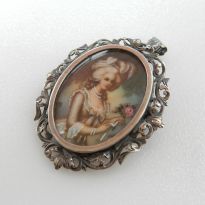
Portrait jewellery was a popular accessory particularly during the Victorian and Georgian period. This sentimental jewellery was worn as brooches or pendants and represented a person captured in time. Portrait miniatures were the photographs of their day. They were worn as a keepsake or love token of family members or loved ones and those departed. Portrait jewellery was worn close to the person. Often on velvet around the neck. Gentleman would wear the jewellery tucked closely to them beneath their shirts.
Portrait jewellery can be painted on ivory, porcelains, paper, shell or mother of pearl. The portraits could be set in silver, gold, filigree and embellished with precious stone borders and paste. Portrait jewellery could also be carved. Carved jewellery also known as cameos would be carved in shell or rock for example, vulcanite being a popular medium.
Mini portraits were often of Royalty, religious icons or military figures. Portraits could also represent every day folk with gypsy children being a favourite subject. Women in the portraits were classical, beautiful, Romanesque. Animals could also feature in these types of jewellery often mythical creatures, doves and swans not being unfamiliar. Portraits varied from dream like to realistic.
Throughout history Royalty has often set the trend for jewellery. Queen Elizabeth and Queen Victoria loved to wear cameos and portrait jewellery.
Identifying the time period of portrait jewellery
If there is no date assay marks, maker stamps or signatures then identifying a time period can be a little more difficult
Earlier pieces of portrait jewellery were found to have finer brush strokes to later pieces
Looking at which way the subject is facing is a good indicator. The most common way for a subject to face is right.
The hinge or pin on the brooch is another good way of seeing whether a piece is old or not.
Portraits with a straight nose are usually Victorian era. Strong Roman noses are found to be pre- 1860s. If the nose is small and sweet looking it is more than likely 19th Century.










